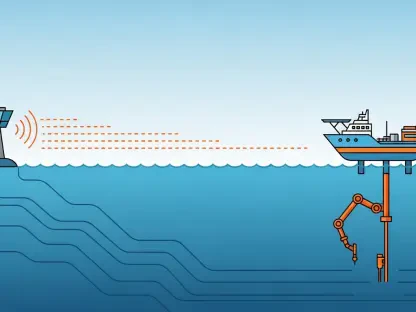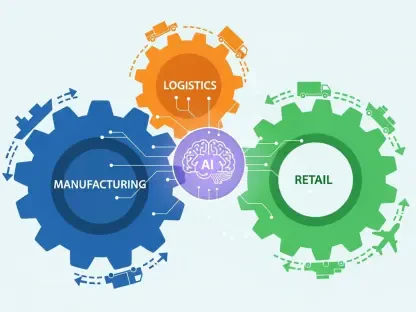Caitlin Laing sat down with Laurent Giraid, a technologist focused on machine learning, natural language processing, and AI ethics, to explore how Europe can convert world-class research and strong values into measurable economic gains. The conversation ranges from a €1.2 trillion opportunity and an AI adoption gap—only 14% of European businesses use AI—to the practicalities of infrastructure, security, and workforce development. Giraid maps a playbook from lab to market, explains how assets like Google DeepMind and AlphaFold can translate into commercialization, and lays out what harmonized rules and skills programs must look like to unlock productivity. He also reflects on where Europe can lead on its own terms, drawing strength from privacy culture, public‑private collaboration, and targeted investment—like the €5.5 billion commitment to Germany and a €15 million fund for vulnerable workers.
Europe’s AI prize is pegged at €1.2 trillion. How do you break that down by sectors and timelines, and what leading indicators would you watch? Walk me through a playbook for capturing it, with examples, milestones, and the metrics you’d track each quarter.
Think of the €1.2 trillion as a stack built from healthcare, manufacturing, automotive, and cybersecurity, with spillovers into services and the public sector. Near-term wins come from sectors with rich data and repeatable workflows—autos and cyber—while healthcare and science ramp as validation cycles complete. I’d watch adoption rates moving from today’s 14%, model access to the latest systems that are roughly 300 times more powerful than two years ago, and the pipeline of pilots graduating into production each quarter. The playbook: select one or two high-value processes, secure compliant data access, run a tightly scoped pilot, harden guardrails, and scale through shared platforms. Each quarter, track time-to-deploy, the share of teams trained, production uptime, and policy readiness, so value and trust rise together.
Only 14% of European businesses use AI. What are the top three blockers you see on the ground, and how have specific firms overcome them? Share a before-and-after story with adoption steps, KPIs, and the cultural shifts that made it stick.
The repeat blockers are data fragmentation, uncertainty about compliance, and a confidence gap in the workforce. The companies that move past this start by consolidating data around a clear use case, aligning with privacy-by-design principles from day one, and pairing domain experts with ML leads. A typical before-and-after arc goes from scattered tools and manual decisioning to a single secure workflow with automated insights and human-in-the-loop oversight. They set KPIs like pilot-to-production velocity, model quality gates, and user satisfaction. The cultural unlock comes when frontline teams see their expertise amplified rather than replaced—training sessions shift fear into fluency, and governance councils codify the guardrails.
Google DeepMind operates from London and AlphaFold supports nearly one million researchers across EMEA. How do those assets translate to commercial wins? Give examples of research-to-product handoffs, the decision gates used, and the time-to-impact you’re seeing in real programs.
Deep research becomes a commercial flywheel when you set clear handoff gates: scientific validity, reproducibility, compliance readiness, and customer fit. AlphaFold’s support for nearly one million researchers shows how discovery can seed ecosystems—startups and enterprises build tools atop that foundation, accelerating drug and materials exploration. In practice, teams formalize transition reviews, run risk and ethics checks, then package models into secure services that product teams can integrate. Time-to-impact compresses as those shared assets, coupled with the latest models that are 300 times more powerful than before, slash iteration cycles. It’s not a single leap; it’s a disciplined relay from lab benchmarks to real-world reliability.
Google just announced €5.5 billion for Germany’s connectivity and infrastructure. Where will that money move the needle first, and how should regional leaders plug in? Outline the phases, key partners, and the ROI metrics you’ll use to judge success.
Connectivity and infrastructure spend lands first in capacity and resilience—low-latency access that lets firms everywhere in the region run advanced models without friction. I’d phase it as build-out, onboarding, and optimization: stand up core infrastructure, onboard priority sectors, then tune workloads and costs as usage patterns mature. Regional leaders should align skills programs and data-sharing agreements so local firms are ready to consume the capacity from day one. ROI shows up in utilization of that new footprint, reductions in deployment time for AI services, and the number of production workloads that shift from pilots. It’s a foundation play: the pipe, the platform, and the people need to be ready together.
You’re standing up Security Operations Centers in Munich, Dublin, and Malaga. How do those sites reflect Europe’s privacy and security edge? Describe the operating model, data safeguards, staffing mix, and real incidents where this setup improved detection or response times.
Locating Security Operations Centers in Munich, Dublin, and Malaga is a signal that privacy and security are not add-ons—they are embedded. The operating model combines local expertise with shared standards: threat intel circulates quickly while data stays governed under European norms. Safeguards hinge on strict access controls, auditable workflows, and privacy-by-design pipelines that separate signals from personally identifiable information. The staffing mix blends seasoned analysts, ML engineers, and policy specialists who translate regulation into day-to-day practice. We’ve seen detection sharpen and response tighten because proximity to European customers and regulators reduces ambiguity—teams don’t just act faster; they act with higher confidence.
You cited Idoven helping doctors spot heart disease earlier. What did they do differently from day one, and how did they win clinical trust? Walk through their data pipeline, validation steps, regulatory path, and the health outcomes or cost savings achieved.
Idoven’s edge started with a clinical-first mindset: align with cardiologists, design for interpretability, and validate rigorously before scaling. Their pipeline emphasizes clean, consented data and models that surface explanations clinicians can interrogate. Trust grows when pilots are co-run with hospitals, results are peer-reviewed, and governance mirrors medical standards. While outcomes vary by setting, the pattern is consistent—earlier detection can translate into better care decisions and lower downstream costs. It’s the European story at its best: science-forward, ethics-forward, and built for real-world impact.
In autos, you mentioned moving from voice assistants to AI co-pilots that detect driver fatigue. What sensors, models, and thresholds make that reliable? Share deployment lessons, safety metrics, and how carmakers measure avoided accidents or warranty costs over time.
Reliability comes from fusing multiple signals—cabin audio, camera cues, and vehicle telemetry—so no single sensor carries the burden. Models are tuned for sensitivity and stability, with thresholds calibrated to minimize false alarms while catching genuine fatigue patterns. Deployment lessons include privacy-by-design cabin analytics and clear human overrides that keep drivers in control. Safety metrics focus on incident rates and system engagement quality, while manufacturers watch service calls and warranty trends for downstream impact. As models become up to 300 times more powerful than just two years ago, inference quality improves and edge deployment becomes more practical.
On cybersecurity, you framed AI as a force multiplier. Which specific workflows see the biggest lift—triage, threat hunting, or response? Give a detailed case showing alert volumes, mean time to detect, mean time to respond, false positives, and the training that made it work.
Triage and threat hunting see the earliest lift, because pattern discovery and prioritization map naturally to AI strengths, and response benefits once signals are trustworthy. A representative journey starts with consolidating telemetry, then tuning models to the organization’s baseline and risk appetite. Teams train on playbooks and red-team scenarios so analysts understand when to lean on automation and when to pivot manually. The payoff shows up as steadier alert volumes, more relevant escalations, and shortened investigation loops. When SOCs sit inside a privacy-anchored framework, confidence rises—what gets automated is not just faster; it’s more controllable.
You noted today’s models are about 300 times more powerful than two years ago. How does that change total cost of ownership and the bar for data quality? Describe the stack choices, fine-tuning steps, guardrails, and the productivity gains per employee you’ve measured.
With models roughly 300 times more powerful, you can do more with fewer bespoke systems, but governance and data quality matter even more. TCO shifts from scattered tools to shared platforms and managed services, where elasticity and security are built in. Fine-tuning moves from heavy bespoke training to lightweight adaptation with strong guardrails—policy filters, safety checks, and audit trails. The practical effect is less time wrangling infrastructure and more time shipping value. Gains per employee are most durable when paired with training, so capability advances translate into confident daily use.
The Commission’s Digital Omnibus was called a step in the right direction. What concrete provisions most help builders, and where do gaps remain? Map out a harmonized path from dataset to production launch, including approvals, timelines, and cross-border data handling.
What helps most are clearer rules that let teams train responsibly while moving to market faster. A harmonized path would start with data access under consistent privacy standards, proceed through transparent risk assessments and model evaluations, then culminate in streamlined approvals for deployment. Cross-border handling should rely on unified definitions and interoperable documentation so firms aren’t redoing the same evidence country by country. Gaps persist where interpretations diverge and timelines stretch unpredictably. The goal is a single, sensible runway that keeps safety high and admin drag low.
You emphasized a unified market with clear rules. How would you phase harmonization so startups and enterprises both benefit? Share a roadmap with quick wins, a pilot region, standard APIs or audits, and the milestones that would unlock faster GDP impact.
Start with quick wins: common templates for consent, model cards, and incident reporting that any firm can adopt. Pilot in a region ready to integrate regulators, universities, and industry, then publish standard APIs for compliance checks and security attestations. As confidence grows, expand mutual recognition so approvals travel across borders. Milestones track adoption of shared standards, the share of AI projects crossing borders without rework, and time from prototype to production. The payoff is a bigger unified market that turns potential into GDP faster.
You’ve helped 15 million Europeans learn digital skills and launched a €15 million AI Opportunity Fund. What programs deliver the biggest lift for vulnerable workers? Give examples with enrollment flows, curriculum hours, job placement rates, wage gains, and employer commitments.
Scale matters, but so does specificity. Programs work best when they meet people where they are—short, stackable modules that build confidence and connect directly to employer needs. With more than 15 million Europeans already touched by digital skills efforts and a €15 million fund focused on vulnerable workers, the model pairs training with real job pathways. Enrollment is friction-light, curricula blend fundamentals with hands-on tooling, and employers engage early so graduates step into roles. The throughline is dignity and mobility: skills that translate into opportunities, not just certificates.
You said Europe needs leaders who spot opportunities and managers who are AI-literate. How do you train that at scale inside large firms? Walk through a 90-day plan: tools, workshops, sandbox projects, measurement, and the incentives that shift behavior.
Day 0 is executive alignment on two or three business problems, not a vague “AI strategy.” In the first 30 days, run leadership workshops on possibilities and limits, while managers get hands-on with sandbox tools and safe datasets. Days 31–60, stand up pilots with clear owners, ethical guardrails, and opt-in teams, then share learnings widely. Days 61–90, graduate the strongest pilots to controlled production and tie incentives to adoption and outcomes. Measurement tracks enablement sessions, pilot conversion, and user satisfaction—confidence grows when people see results in their own workflows.
Europe has talent, values, and infrastructure. What should founders do in the next six months to turn that into traction? Outline a step-by-step play: data partnerships, model selection, compliance checks, go-to-market tests, and the three metrics investors should see by month six.
Month one, secure a data partner and lock the privacy posture; month two, select a model fit for purpose with clear safety filters; month three, run a closed beta with design partners. Months four to six, harden reliability, pass compliance checks aligned to the Digital Omnibus direction of travel, and run focused go-to-market tests. Investors should see a working product with real users, a repeatable onboarding process, and a path to scale on modern infrastructure. Keep it simple: one wedge, one customer segment, one proof that value compounds over time.
With global competition from the US and China, where can Europe play to win on its own terms? Share concrete niches, procurement levers, public-private labs, and a timeline, plus one story where Europe’s privacy culture created a market advantage rather than a hurdle.
Europe can lead where trust, safety, and scientific depth are decisive—healthcare, automotive safety, and cybersecurity anchored in strong privacy norms. Public procurement can favor privacy-by-design and interoperability, turning compliance into a competitive edge. Public‑private labs can pair university research with industry deployment, accelerating the path from breakthrough to product. A vivid example is healthcare tools like Idoven: by prioritizing clinical trust and privacy from day one, they opened doors that speed-focused competitors couldn’t. That’s Europe’s lane—values as an accelerant, not a brake.
Do you have any advice for our readers?
Start smaller and sooner than feels comfortable. Pick one process, one dataset, one team, and prove that modern tools—now up to 300 times more powerful than two years ago—can deliver safe, repeatable value. Invest in skills, because confidence is the multiplier; more than 15 million Europeans have taken that first step, and it changes the trajectory. Finally, lean into Europe’s strengths: privacy, security, and scientific rigor aren’t constraints—they’re the foundation of durable advantage.









